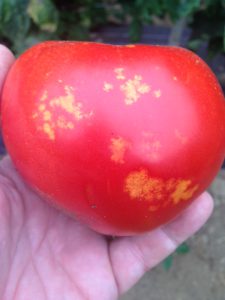Sweet Corn
European corn borer (ECB) moth catches in black light traps, after showing signs of increase, have now largely subsided again. The second flight is most likely going to be spotty, with specific locations getting low numbers of moths while other regional traps catch none. There will be no map in this edition. While we expect to see some feeding signs over the next two weeks, this second generation feeding is sometimes obscured by fall armyworm (FAW) feeding. Once plants hit full tassel, any ECB larvae present will move downward on the stalk and re-enter the plant near the area where ears are forming. This can result in direct injury to the ear. Growers should consider an insecticide application at the full tassel stage to target ECB larvae as they migrate downward. This application can eliminate larvae that have escaped any earlier insecticide applications.
The highest nightly trap catches of ECB for the week ending 7/25/18 are as follows:
| Chester 1 | Folsom 1 |
| Cinnaminson 1 | Morristown 1 |
| East Vineland 1 | Sergeantsville 1 |
| Flanders 1 | Woodstown 1 |
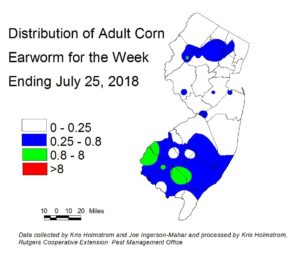 The air flow that we are currently experiencing is bring a limited but significant number of corn earworm (CEW) moths to New Jersey. There have been inconsistent catches in NJ black light traps, but several traps throughout the state are indicating an economically damaging population. The CEW pheromone trap network in the southern counties is showing a similar increase (see CEW blacklight map at left, and pheromone trap map at lower right). While most activity is in south Jersey, there continue to be important catches in the Musconnetcong river valley in Warren County and eastward through
The air flow that we are currently experiencing is bring a limited but significant number of corn earworm (CEW) moths to New Jersey. There have been inconsistent catches in NJ black light traps, but several traps throughout the state are indicating an economically damaging population. The CEW pheromone trap network in the southern counties is showing a similar increase (see CEW blacklight map at left, and pheromone trap map at lower right). While most activity is in south Jersey, there continue to be important catches in the Musconnetcong river valley in Warren County and eastward through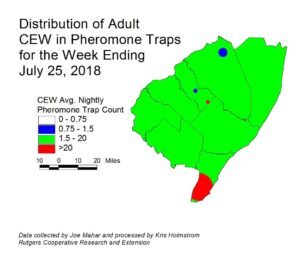 central Morris County. There are many fewer pheromone traps than blacklight traps. This results in much broader colored patches on the pheromone maps. The blue area on the blacklight map indicates an approximate 4-5 day silk spray schedule, while green would be 3 days. On the pheromone map, the green area corresponds to a 3-5 day schedule depending on location. This week, growers near the lower Delaware River and in southern Burlington and Cape May should adhere to the tighter schedule within that range. Trap catches from Virginia and Delaware are moderate to low. The moths trapped this week in NJ do not represent a major migratory event like the ones we typically get in mid August and later. Expect an economically important, but overall low population to persist in NJ while this southerly airflow persists. Growers of Attribute I and Performance Series sweet corn (expressing B.t. traits) should consider adhering to silk spray schedules prescribed for non B.t. sweet corn. At this time, Attribute II varieties are non known to support CEW larvae.
central Morris County. There are many fewer pheromone traps than blacklight traps. This results in much broader colored patches on the pheromone maps. The blue area on the blacklight map indicates an approximate 4-5 day silk spray schedule, while green would be 3 days. On the pheromone map, the green area corresponds to a 3-5 day schedule depending on location. This week, growers near the lower Delaware River and in southern Burlington and Cape May should adhere to the tighter schedule within that range. Trap catches from Virginia and Delaware are moderate to low. The moths trapped this week in NJ do not represent a major migratory event like the ones we typically get in mid August and later. Expect an economically important, but overall low population to persist in NJ while this southerly airflow persists. Growers of Attribute I and Performance Series sweet corn (expressing B.t. traits) should consider adhering to silk spray schedules prescribed for non B.t. sweet corn. At this time, Attribute II varieties are non known to support CEW larvae.
The highest nightly black light trap catches of CEW for the week ending 7/25/18 are as follows:
| East Vineland 3 | Centerton 1 | Milltown 1 |
| Hackettstown 2 | Denville 1 | Sergeantsville 1 |
| Pedricktown 2 | Flanders 1 | Tabernacle 1 |
| Allamuchy 1 | Folsom 1 | Woodstown 1 |
The highest nightly pheromone trap catches of CEW for the week ending 7/25/18 are as follows:
| Green Creek 32 | Pedricktown 6 | Jobstown 2 |
| Elm 22 | Beckett 3 | Belvidere (Warren Co.) 1 |
| Woodstown 11 | Monroeville 3 | |
| East Vineland 8 | Berlin 2 |
Silking Spray Schedules*:
South – 3 days
Central – 4-5 days
North – 5-6 days
*These recommendations are based on regional catches. Adhere to tighter spray schedules if indicated by local trap catches.
Fall Armyworm
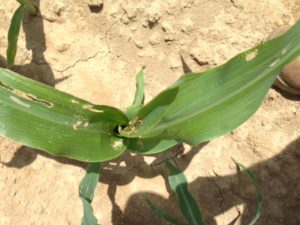 Fall armyworm (FAW) infestations have not progressed much this past week. Infestations remain fairly low , even in coastal regions. This situation may worsen over the next week if more egg laying occurs during the warm, humid weather we are experiencing. Look for
Fall armyworm (FAW) infestations have not progressed much this past week. Infestations remain fairly low , even in coastal regions. This situation may worsen over the next week if more egg laying occurs during the warm, humid weather we are experiencing. Look for  significant injury in whorls, with all damage leading directly into the center of the plant (see photo at left). FAW larvae consume lots of tissue, and grow rapidly (see photo at right). Be sure to check seedling stage plantings as well, as FAW will attach even small plants. Consider treating if plants infested with FAW alone, or in combination with ECB exceed 12%. FAW is resistant to synthetic pyrethroid insecticides. Effective materials include those in IRAC groups 5 (Radiant, Entrust (OMRI approved)), and 28 (Coragen, Exirel).
significant injury in whorls, with all damage leading directly into the center of the plant (see photo at left). FAW larvae consume lots of tissue, and grow rapidly (see photo at right). Be sure to check seedling stage plantings as well, as FAW will attach even small plants. Consider treating if plants infested with FAW alone, or in combination with ECB exceed 12%. FAW is resistant to synthetic pyrethroid insecticides. Effective materials include those in IRAC groups 5 (Radiant, Entrust (OMRI approved)), and 28 (Coragen, Exirel).
Pepper Weevil
We continue to trap weevils at the one, known infested field in the Hammonton area. No weevils caught at other locations.
Beet Armyworm (BAW)
Pheromone trap catches of BAW in southern NJ are fairly high near Woodstown and Jones Island, but low elsewhere. At this time, there are no known field infestations.
There has been an slight increase in the appearance of native brown stinkbugs injury in tomatoes this past week. As we progress kthrough July, it is worth noting that this is typically the time of the season when our native brown stinkbugs become active; seeking sites on which to feed and lay eggs. This can be an economic problem for our field tomato plantings, and dry conditions will help drive stinkbugs from normal forage sites into irrigated crops. Stink bug feeding results in pale blotches on green fruit, that turn yellow as the fruit ripen to red (see photo at right). Picking crews often notice this damage first, as they see the greatest volume of overall fruit. If this damage is increasing, and/or adults, nymphs or egg masses are occurring in scouting samples, consider treating. See the tomato section of the 2018 Commercial Vegetable Recommendations Guide for appropriate materials.
With very warm, wet weather, foliar diseases of tomatoes are sure to increase. Be sure to monitor the tomato/potato disease forecasts generated from the RAREC station. This information appears weekly via the Plant and Pest Advisory. Labeled products are found in the tomato section of the 2018 Commercial Vegetable Recommendations Guide.
Brown marmorated stink bug (BMSB)
BMSB catches in black light traps remain low and have sunk to levels that do not permit a map image. The most consistent catches occurred in western Salem county. Although this pest has not had serious impact on vegetable crops like peppers in recent years, it is still a significant pest of tree fruits.
The highest nightly trap catches of BMSB for the week ending 7/25/18 are as follows:
| Hillsborough 3 | Crosswicks 1 | Milltown 1 |
| Newton 2 | Farmingdale 1 | Pedricktown 1 |
| Woodstown 2 | Jobstown 1 | Princeton 1 |
| Belvidere 1 | Lawrenceville 1 | South Branch 1 |
Pumpkins and Winter Squash
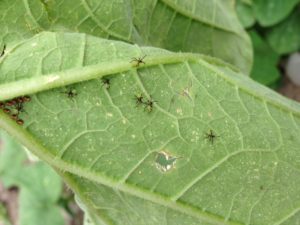 Many fields are now developing squash bug populations. The squash bug lays copper colored egg masses on leaves. As eggs hatch, clusters of green nymphs will remain near the hatch site (see photo at left). As nymphs grow, they go through several molts and change to a gray color. These insects can become quite numerous, but are generally not a threat to pumpkins and winter squash, once those plants have begun to run. Later in the summer, it may be advantageous to eliminate populations from U-pick fields, but prior to that, little economic injury occurs on these crops.
Many fields are now developing squash bug populations. The squash bug lays copper colored egg masses on leaves. As eggs hatch, clusters of green nymphs will remain near the hatch site (see photo at left). As nymphs grow, they go through several molts and change to a gray color. These insects can become quite numerous, but are generally not a threat to pumpkins and winter squash, once those plants have begun to run. Later in the summer, it may be advantageous to eliminate populations from U-pick fields, but prior to that, little economic injury occurs on these crops.
Cucurbit Downy Mildew
 Cucurbit downy mildew (CDM) has been found on cucumbers in Salem and Warren counties. CDM causes yellow “panels” to develop on the upper leaf surface (see photo at left) with dark sporulation forming on the lower leaf surface (see photo at right). CDM can defoliate fields in a matter of several days during wet conditions such as we are currently enduring. As of 7/24, the only reported incidence of this disease has been on cucumbers, and all growers should be treating preventively for CDM on that crop. No pumpkin fields have yet been found to be infected in our region. A sentinel plot of mixed
Cucurbit downy mildew (CDM) has been found on cucumbers in Salem and Warren counties. CDM causes yellow “panels” to develop on the upper leaf surface (see photo at left) with dark sporulation forming on the lower leaf surface (see photo at right). CDM can defoliate fields in a matter of several days during wet conditions such as we are currently enduring. As of 7/24, the only reported incidence of this disease has been on cucumbers, and all growers should be treating preventively for CDM on that crop. No pumpkin fields have yet been found to be infected in our region. A sentinel plot of mixed 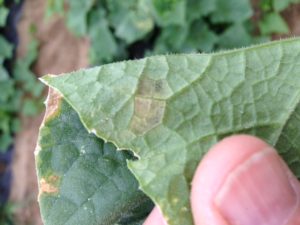 cucurbits, (cucumbers, pumpkin, butternut and acorn squash, muskmelon and watermelon) has been established at Snyder Research and Extension Farm in Hunterdon County. Another of these plots is at RAREC. These unsprayed plots are designed to alert growers to the presence of CDM in the area and WHAT CROP(s) are impacted. Many growers in the northern NJ counties have limited acreage of cucumbers, but extensive pumpkin acreage. For this reason we go to great lengths to determine host occurrence so that fungicide programs are not initiated unnecessarily. At the present time (7/24/18), no cucurbit crops at Snyder Farm are infected. For detailed CDM forecasts, see the following website: http://cdm.ipmpipe.org/ All growers are encouraged to check this website at least once a week. NJ was considered to be at moderate risk for spread from existing sites through Wednesday of this week. Thursday’s forecast is moderate for NJ.
cucurbits, (cucumbers, pumpkin, butternut and acorn squash, muskmelon and watermelon) has been established at Snyder Research and Extension Farm in Hunterdon County. Another of these plots is at RAREC. These unsprayed plots are designed to alert growers to the presence of CDM in the area and WHAT CROP(s) are impacted. Many growers in the northern NJ counties have limited acreage of cucumbers, but extensive pumpkin acreage. For this reason we go to great lengths to determine host occurrence so that fungicide programs are not initiated unnecessarily. At the present time (7/24/18), no cucurbit crops at Snyder Farm are infected. For detailed CDM forecasts, see the following website: http://cdm.ipmpipe.org/ All growers are encouraged to check this website at least once a week. NJ was considered to be at moderate risk for spread from existing sites through Wednesday of this week. Thursday’s forecast is moderate for NJ.
Basil
A basil sentinel plot at Snyder Farm in Hunterdon County, now in full flower, has not yet been infected with basil downy mildew.
Torac (insecticide) is now registered for use in New Jersey
Torac (tolfenpyrad) is an IRAC group 21A insecticide that is now labeled for fruiting vegetables to help control thrips, among other insects. Earlier this year, the EPA approved the label expansion to include fruiting vegetables. Thrips control continues to be a persistent problem, especially with favorable conditions (hot and dry) that we had experienced prior to this recent bout of wet weather. Torac will add a different mode of action that may be alternated with other chemistries to make thrips control easier and help prevent resistance. It is noteworthy that IRAC 21A materials include the miticide Portal.
Torac is also labeled for control of pepper weevil on peppers and eggplant. This adds another material that may help manage this important pest.
